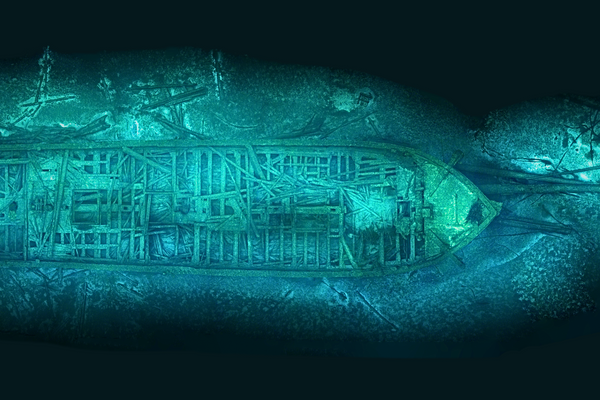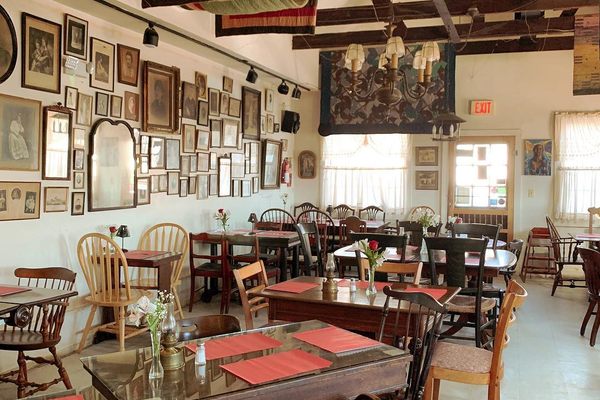The Real Women Behind ‘Christmas in Connecticut’
The 1945 Barbara Stanwyck film is a classic for its charming portrayal of a food writer who can’t cook. It had its basis in real life.
Elizabeth Lane has a secret. Nominally, she is a food writer by trade: In her magazine column, “Diary of a Housewife,” she dispenses her culinary know-how to millions of American housewives during World War II, regaling them with recipes for crinkly endive salads with blue cheese dressing and roast goose with giblet gravy. Meanwhile, her lush chronicles of life on a bucolic Connecticut farm, where she lives with her husband and eight-month-old child, enchant male soldiers bandaged up in hospital beds.
There is just one problem: Her entire column is predicated on a lie.
Lane, the protagonist of the 1945 Hollywood film Christmas in Connecticut, has been engaging in elaborate professional cosplay for years. She has no spouse, no kid; her actual abode is a Manhattan apartment with a hissing radiator, not a plush cottage in rural New England. She’s also a lousy cook. Lane sources her recipes from a friend who works as a chef. Though she can barely flip a flapjack, Lane has a gift for spinning fiction so convincingly on the page that it can easily pass as fact.
Lane’s efforts to conceal her dupery animate this romantic comedy, now a beloved holiday classic. As played by Barbara Stanwyck, Lane is not some unsympathetic charlatan. Rather, she’s a relatable woman who’s desperately trying to tunnel herself out of a mess of her own making. These endearing foibles might account for why Christmas in Connecticut endures nearly eight decades since its release.

But one question that’s chewed at avid fans of the movie—this writer included—is who, exactly, inspired Elizabeth Lane. Over the years, divergent theories have pointed to disparate names, all drawn from the constellation of female food and lifestyle writers who had Americans in their thrall during the war years. But archives like the Barbara Stanwyck Papers don’t provide clarity. Who was the real Elizabeth Lane, if such a person existed at all? Ask different people and you’ll hear different answers.
Anne Colby never questioned that her grandmother, Gladys Taber, inspired Christmas in Connecticut. The knowledge was so ingrained within her family that she accepted it as gospel. Now, Colby remains certain that her grandmother’s work “must have provided at least the seed for the idea for this charming, very funny romantic comedy,” as she tells me. The notion that Taber was the model for Elizabeth Lane has since become the dominant theory about the character’s provenance, the stuff of trivia dotting IMDb pages and explored in articles in the local Connecticut press.
Taber was one of the most prominent and prolific lifestyle writers of her day, churning out magazine columns on pastoral living and cooking along with over 50 books until her death in 1980, at age 80. Though Taber could, unlike her filmic analog, cook quite well—she wrote five cookbooks—she, like Elizabeth Lane, embodied the prototypical domestic goddess in American culture. Many of her other books documented her life on Stillmeadow, the 1690 farmhouse in Southbury, Connecticut, where she lived (these days, Colby maintains the home).
Despite this vast corpus, Taber’s writing was anything but workmanlike. It retains a unique power decades later—so much that there are over 500 members of the Friends of Gladys Taber, an organization of Taber’s acolytes across America, Canada, Sweden, Finland, even Australia, who safeguard her legacy.

Taber’s public writing career began during the thick of the Great Depression, when her husband lost his hearing and had to leave his job as a music teacher and composer. This drove Taber to “become very, very serious about her writing to support the family and a small child in the middle of the Depression,” Colby explains.
The family decamped from New York City to Stillmeadow, and, from there, she began writing her monthly dispatches for the magazine Ladies’ Home Journal called “Diary of Domesticity,” her column name bearing an uncanny resemblance to Elizabeth Lane’s “Diary of a Housewife.” There, Taber wrote lucidly about the challenges of daily life on a farm. Her column ran from 1937 until 1957 and lifted her to national fame.
Taber belonged to a broader coterie of female journalists writing about food and lifestyle around World War II. “One of the major sources of income for professional women writers in that era was these women’s magazines,” Colby says. “So there were food writers starting up, and there was the sort of country-living nostalgia during the war and post-war that was feeding into an interest for this.”
The circle of female writers Taber ran in could also feel like a small world, and Colby surmises that one of the film’s two screenwriters—Adele Comandini, the New York-born daughter of Italian immigrants—may have crossed paths with Taber, who occasionally traveled to New York from Connecticut. After all, Taber was still writing for a publication headquartered in the city. (Documentation confirming any definitive connection between Taber and Comandini is difficult to find, as is any that firmly associates Taber with the film’s other screenwriter, Lionel Houser, or Aileen Hamilton, who wrote the story upon which the film is based.)

Colby added that 1945, the year of Christmas in Connecticut’s release, was when Taber’s column was at the peak of its popularity. This temporal overlap, plus the symmetry of the column titles, makes the link between Taber and Lane probable. The likeness may have seemed so clear at the time that there was no need to make it explicit. “It might have just seemed so obvious that it was just as today, we know if someone’s doing a Martha Stewart impression—we know who they’re talking about,” Colby says.
Still, there are rather significant—and meaningful—differences between Taber and Lane, starting with the fact that Taber was a highly able cook, unlike Stanwyck’s maladroit klutz in the film. That said, Taber’s columns did not strictly limit themselves to food. “It was a big part of her column, but she was not per se a ‘food writer,’” says Colby.
More crucially, Colby stresses that Taber’s career was no charade. “My grandmother really lived the life she wrote about,” Colby says. “It was not a fantasy, and in fact her column, and its enduring appeal, was that she did not romanticize rural life.”
You may have to look elsewhere to find the source for Elizabeth Lane’s other defining traits, such as her lack of kitchen prowess. It was around 2005 when a colleague approached the journalist and academic Kelly Alexander and told her that Christmas in Connecticut may have been based on Clementine Paddleford. The possibility hadn’t occurred to Alexander in all her years of researching the accomplished food journalist’s life and career for Hometown Appetites (2008), the biography of Paddleford that Alexander co-authored with Cynthia Harris.

Alexander now thinks it’s “pretty likely” that Paddleford inspired Lane, she tells me. She’s not alone: Speculation along those lines has become increasingly popular, albeit secondary to the Taber hypothesis.
The bulk of Paddleford’s journalistic output was for the New York Herald Tribune, the newspaper she began writing for in 1936 as food editor until the publication’s demise 30 years later, along with her weekly “How America Eats” column for This Week from 1940 until her death in 1967. Itinerance defined Paddleford’s work: A licensed pilot, she often embedded with cooks across the country in their kitchens, cooking with Cuban women who had just arrived in Ybor City, Florida, to make ribbons of shredded beef for ropa vieja, for example. But she also kept a country home in Connecticut—just as Elizabeth Lane pretended to—where Paddleford would sometimes spend holidays, Christmas included.
Like Elizabeth Lane, Paddleford wasn’t the finest of cooks, though she was certainly proficient. (Alexander also sees shades of one of Paddleford’s contemporaries, Cecily Brownstone—who was a food writer whose animating obsession was more writing than cooking—in Lane, though Brownstone’s claim to renown was her post as the food editor of the Associated Press, a job she didn’t get until 1947, two years after the film’s release, making the odds of a link somewhat dubious.) The most involved meals Paddleford would make herself were steaks with sides of potatoes; typically, though, she’d just make a can of soup for dinner. “That feels like Elizabeth Lane to me,” Alexander adds.
But Paddleford had enormous name recognition in her heyday, which—along with her Connecticut countryside house—firms up the case for her as a potential blueprint for Elizabeth Lane. “At the time, you would’ve been hard-pressed in America to find somebody who hadn’t heard of her,” Alexander says. Her writing was the subject of a New Yorker poem in 1941, for example, in response to a column she wrote about beach plums. In the years that followed Christmas in Connecticut’s release, Paddleford would become an even greater part of America’s cultural vernacular, with Time Magazine naming her the country’s “Best-Known Food Editor” in 1953.

Like Lane, Paddleford also had crossover appeal. According to New York Herald Tribune reader surveys that Alexander found, Paddleford’s readership was a near-even split between men and women. “Her celebrity as a reporter would’ve meant that if you wanted to make this film, she would’ve been your go-to,” Alexander says.
Traveling, Alexander says, lent Paddleford’s project the patina of legitimacy, allowing her to muscle her way to respectability in a vocation dominated by men. It’s true that Elizabeth Lane was happily stationary in her Manhattan digs, unlike Paddleford. “But you can see, to me, lots and lots of parallels of this woman who was very interested in being a reporter and for whom food was the only thing she would be taken seriously to write about,” Alexander insists.
Colby, Taber’s granddaughter, agrees: Lane was, like many female journalists of that era, trying to game a system rigged against her. “The only way this obviously talented writer can make a paycheck is to write for a domestic magazine and to fake being domestic,” Colby says.
What women like Taber and Paddleford loved, like Elizabeth Lane herself, was writing. Each woman saw food as a vehicle for her craft, a way for her to assert herself in a world that could easily have kept her down.
“I am guessing that Taber and Paddleford’s lives and careers both inspired the story of Elizabeth Lane,” says Kimberly Voss, an author and professor whose work often focuses on the history of women in American journalism (especially subjects like food, occupying what was once called the “woman’s page”). Indeed, the evidence on hand points to Lane being an amalgamation of different female journalists of that era. Voss finds it plausible that Jane Nickerson, the first food editor of the New York Times, from 1942 to 1957, could have provided the template for Lane. Nickerson’s work spanned both hard and soft news; she could write as ably about food rationing during World War II as the varieties of cheese sold at a Brooklyn department store. Like Lane, Nickerson was fighting to be respected as a journalist.
That there’s no sole real-life counterpart for Lane might not be terribly surprising. Rather, it reveals a certain truth about that period in history when women like Taber and Paddleford were ubiquitous in the American mind, explains Voss.
“Typically, women in these roles became national or local celebrities, based on the publication,” Voss says. “While the film highlights what might seem like an irony that she could not cook, it was not unusual at the time, as many newspapers and magazines employed home economics–educated recipe testers. Often the food editor considered herself a writer and expert on food rather than a cook.”
The influence of these women reaches into present generations: Voss notes that Cecily Brownstone, for example, popularized the serving of green bean casserole at Thanksgiving, a tradition that continues today. Colby still receives visitors from her grandmother’s fans who burst into tears upon setting foot on Stillmeadow’s soil. She sometimes asks them what it is about Taber’s work that speaks to them.
“What I hear is that the lasting appeal is that she wrote about challenges of daily life, she wrote about hardship, and also successes of living with a lot of humor in very simple language, but I think very beautiful language,” Colby says.
You could say the same for Christmas in Connecticut, a film that gives shape to that familiar struggle of tackling an unforeseen hurdle with grace, guile, and an ability to laugh at yourself. But the film may also now be a reminder of a time when America relied upon journalists like Taber and Paddleford to explain the world to them, to keep them sated in more ways than one—and to write about reality so magically that it read like fantasy.
Gastro Obscura covers the world’s most wondrous food and drink.
Sign up for our regular newsletter.


















Follow us on Twitter to get the latest on the world's hidden wonders.
Like us on Facebook to get the latest on the world's hidden wonders.
Follow us on Twitter Like us on Facebook